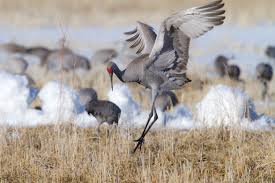
Where were the cranes?
After driving four and a half hours, with the anticipation building, there weren’t here. Just a few ducks and a rogue goose.
This was fast turning into a wild crane chase.
It all started last week while listening to Colorado Public Radio. One of reasons I appreciate public radio is hearing about esoteric things I might otherwise remain oblivious to. This used to happen when I read a good old-fashioned print newspaper. It was one of my private pleasures — sitting on the back deck, reading through the Sunday paper and seeing weird articles in the back pages.
But ever since everything is gone digital, I don’t have that experience anymore. I tend to read what’s on the front webpage and maybe in another section, but I don’t come across those human interest stories so much.
As I drove to the store on an errand, I listened to the good folks at CPR talk about Sandhill Cranes. “Every year, on their spring migration, they stop in Monte Vista, Colorado. Thousands of them populate the fields in the area. The best place to see them? Try visiting the Monte Vista National Wildlife Refuge.”
And so the seed was planted. After all, who doesn’t love a good road trip?
We embarked mid-morning on our drive to southern Colorado. The drive itself was worth the trip as we wound our way down through Leadville and Buena Vista. The Collegiate Mountains towered to the west — Mt. Princeton, Mt. Yale, Mt. Harvard – remind of us Fourteeners climbed.
Finally, the snow receded as we move into the San Luis Valley and made our way towards Monte Vista. Occasionally, we’d see flocks of birds moving overhead in the class V formation.
“Are those geese or cranes?” Bryon queried.
I’d read the Sandhill Cranes were very large birds, standing four to five feet tall, with a 7-foot wing span. They had very long necks, with a blotch of red on the head. They can be seen twice a year in the valley — in late winter/early spring and then again in the fall. Stopping here to rest and regain their energy for the rest of their flight up north this time of year.
One of the fascinating things I read about the cranes is their courtship rituals. They mate for life but renew their courtship each spring by engaging in some unique behaviors — bowing, chortling, dancing and throwing tufts of grass into the air.
Finally after almost five hours of driving we arrived at the wildlife refuge. Apparently, the cranes were a big drawing card as we spied several vehicles driving the 2 1/2 mile loop road. Several times people were parked with lawn chairs, binoculars and some serious camera equipment. I felt woefully unprepared as in our hurry to hit the road, I’d even forgotten our binoculars.
We looked left and right of the road, but only spotted a few small ducks and other water fowl.
“This is turning into a wild crane chase…” I said.
Bryon chuckled.
As pulled into the parking lot, wondering what to do, wings filled the air over our heads. A cacophony of noise filled my ears. A very loud chattering and thrumming came from the birds. So many of them — too many to count — wings flapping and those long necks stretching ahead as they soared through the air.
“There they are!”
Then as quickly as they came they made a U-turn and headed back, lighting into the fields across the road. Then we realized all those dark dots we saw way out in the field were in fact, cranes.
We decided to walk the road, spying a few cranes here and there standing in the wetlands. Their spindly legs supporting their broad bodies — what large birds they were. We saw other types of birds as well, hanging out in the grasses — some water birds with red bodies.
“I wish I’d brought my bird book!” I said to Bryon.
It also gave us a chance to appreciate the solitude and beauty of this valley — the Great Sand Dunes looming in the distance. Groups of snow-capped mountains ringed the area.
In that moment, I could understand why the cranes chose this spot to take a break and re-charge.
The chase was over and our day was complete.

